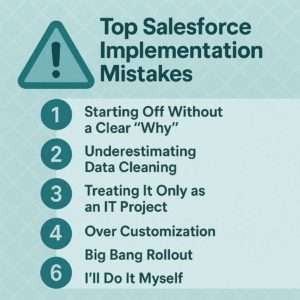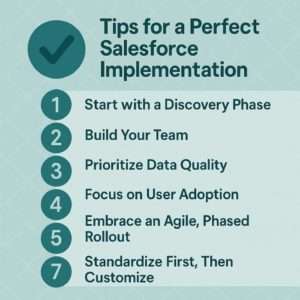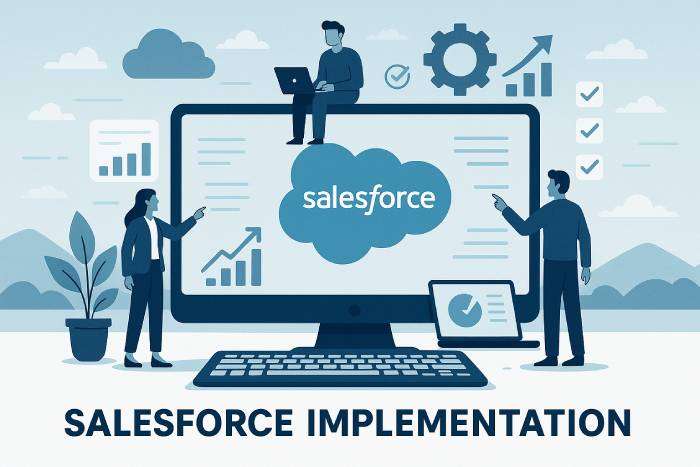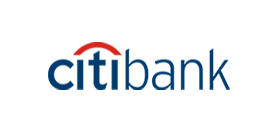Since 1999, Salesforce has been the backbone of sales and marketing for innumerable businesses, both large and small. With over 150,000 users, Salesforce is the #1 CRM provider in the world. It’s the default name that comes up when we think of CRM, and rightfully so.
The level of customization, features, and scalability provided by Salesforce is yet to be rivaled by any other CRM. Companies using Salesforce report an average of 25% savings on IT costs and a 26% increase in employee productivity.
However, Salesforce doesn’t work just like that. You need to implement it correctly to reap all the benefits it has to offer. And Navsoft is here to guide you.
From our 26 years of experience, we’ve worked with hundreds of clients. Based on our experience, we’ve compiled a list of Salesforce implementation pitfalls we’ve seen many businesses face and suggested the correct way to avoid them.
This blog will serve as a roadmap for your Salesforce implementation process and ensure success on your first attempt.
Top Salesforce Implementation Mistakes
Let’s dive right in. Implementing Salesforce requires a significant investment in time and resources. This makes it imperative that you get it right the first time. The best way to ensure success is to learn from the mistakes of others. With 26 years in the field, we’ve seen a lot. Let us show you where the traps are so you can sail smoothly to success.

1) Starting Off Without a Clear “Why”
Starting Salesforce implementation without a crystal-clear understanding of what you want to achieve means going on a journey with no idea about the destination. It’s, without a doubt, the number one reason implementations go off the rails.
Many businesses buy CRM because they’ve heard that it’s the best CRM. But what does best mean for you? Don’t jump to the technical setup without having an answer to this question. It can lead to:
Wasted Resources: You spend money on features and licenses you don’t need and time developing solutions for problems you don’t have.
Misaligned Teams: Your sales team thinks the goal is better lead tracking, marketing wants better campaign analytics, and service wants faster case resolution. Without a unified vision, everyone pulls in different directions.
Failure to Measure Success: How do you know if the implementation was successful if you never defined what success looks like? You can’t calculate ROI on a vague feeling.
Here’s what Navsoft recommends to avoid this:
- Perform an in-depth analysis of your business’s requirements and objectives.
- Create a comprehensive Salesforce implementation plan that encompasses all the requirements, timeline, steps, and budget.
2) Underestimating Data Cleaning
Garbage in, garbage out. Your CRM is only as effective as the data within it. Many companies treat data migration as a simple copy-paste job, an afterthought in the implementation process. This is a catastrophic mistake.
Your existing data may be spread across multiple old systems. It could be filled with duplicates, outdated information, and inconsistencies. Simply copy-pasting this into Salesforce will affect the quality of insights you get. That’s not all. The consequences extend far beyond:
Zero User Trust: If a sales rep pulls up a contact and finds three duplicates with different phone numbers, they will immediately lose faith in the system. Adoption will plummet.
Flawed Analytics: Your new dashboards and reports will be meaningless if they’re built on inaccurate data.
Wasted Time and Effort: Your team will spend more time cleaning up data inside Salesforce after the launch than they would have if they’d done it correctly from the start.
Here’s what Navsoft recommends to avoid this:
- Analyze your data and find any errors.
- Take your time to remove any duplicates and clean the data before migration.
3) Treating It Only as an IT Project
Salesforce implementation is more than just a tech project. It’s business transformation that enhances your core operations and processes. However, it won’t succeed as long as there is human resistance to adoption.
When a new CRM is handed down from on high with little explanation or training, employees see it as just another task, another system they are being forced to learn. They don’t understand why it’s important for them.
Even after a successful implementation, if the employees don’t use it, your ROI will be zero.
Here’s what Navsoft recommends to avoid this:
- Train all employees, according to their roles, and get them familiar with Salesforce.
- Create a change management strategy to ensure everyone gets on board.
4) Over Customization
Customizability is Salesforce’s greatest strength. However, it can also be its greatest weakness when misused. It’s tempting to want to bend Salesforce to fit every single one of your existing processes perfectly. This often leads to over-customization.
You end up creating a clunky, overly complex system with convoluted page layouts, too many fields, and fragile custom code.
On the flip side, some businesses only rely on the out-of-the-box functionality provided by Salesforce, even when it’s a poor fit for their business.
Both overcustomization and undercustomization are critical Salesforce implementation pitfalls that lead to:
Technical Debt: Over-customization creates a mountain of technical debt. Every new Salesforce release could potentially break your custom code, leading to expensive and time-consuming fixes.
Poor User Experience: Too many fields and cluttered layouts make it hard for users to find the information they need, slowing them down and causing frustration.
Scalability Issues: Your heavily customized system might work for your current team of 20, but it may grind to a halt when you try to scale to 100 users.
Here’s what Navsoft recommends to avoid this:
- As mentioned in point 1, clearly define what you want.
- Try to use end-to-end functionalities before opting for customizations.
- Execute business-critical customizations first.
- Evaluate customizations periodically to see if they match your evolving requirements.
5) Big Bang Rollout
The “Big Bang” approach is when you try to launch everything, for every user, in every department, all on the same day. On paper, this sounds efficient and fast, but is very prone to risks.
With so many moving parts, the potential for failure is immense. A single bug, a misunderstood workflow, or a server issue can bring the entire launch to a screeching halt, impacting the whole company. It puts immense pressure on the project team and leaves no room for learning or adjustment.
Overwhelming Change: Users are hit with a wave of new processes and features all at once, leading to confusion and anxiety.
Magnified Risk: Any small problem becomes a major crisis when it affects the entire organization. It’s much harder to troubleshoot and fix issues when everything is on fire simultaneously.
Delayed ROI: A rocky “Big Bang” launch can set your project back by months, delaying the benefits you were hoping to achieve.
Here’s what Navsoft recommends to avoid this:
- Follow a phased approach to rollout so that everything is under control.
- Deploy Salesforce during weekends to minimize disruption.
6) I’ll Do It Myself
Many businesses venture into Salesforce implementation without having the required expertise, believing it’s easy. This usually leads to them falling into the above-mentioned Salesforce implementation pitfalls and many more issues:
Extended Timeline: The project ends up becoming more complicated and harder to manage than expected, leading to frequent delays.
Errors Pop Up: A lot of errors and barriers can pop up during the Salesforce implementation process due to a lack of expertise.
Budget Overflow: An extended timeline also means an extended budget, as your developers have to work longer.
Here’s what Navsoft recommends:
- Outsource Salesforce implementation to a reputed and experienced vendor.
- Opt for an expert overview of your Salesforce implementation process and periodic check-ins.
Tips for a Perfect Salesforce Implementation
Avoiding the Salesforce implementation pitfalls is just half the battle. The other half is proactively taking the right steps. A successful implementation requires a deliberate, methodical approach. Having successfully implemented Salesforce for multiple clients globally, Navsoft has created a checklist for getting it right.

1. Start with a Discovery Phase
Before you write a single line of code, you must create a roadmap. This is the most critical phase.
- Define Your Vision: Don’t just say, “We want to improve sales.” Get specific. A better vision is: “We want to reduce our sales cycle by 15% and increase cross-selling by 20% within 12 months.”
- Gather Requirements: Talk to everyone. Interview your sales reps, marketing managers, customer service agents, and senior leaders. Understand their daily pain points and what they need to succeed. This is not the time for assumptions.
- Create a Roadmap: You can’t do everything at once. Prioritize your goals. What’s most important? What will deliver the biggest impact quickly? Create a phased roadmap:
- Phase 1: Launch core Sales Cloud functionality for the sales team.
- Phase 2: Integrate marketing automation with Pardot.
- Phase 3: Roll out Service Cloud for the support team.
This roadmap manages expectations and gives you a clear path to follow.
2) Build Your Team
You can’t do this alone. A successful implementation requires a dedicated, cross-functional team.
- Executive Sponsor: Your high-level champion who removes obstacles and champions the project’s vision.
- Project Manager: The day-to-day leader who keeps the project on track, on time, and on budget.
- Salesforce Administrator: The technical owner of the system. This person will be critical both during and after implementation. Don’t just assign this role to “the IT guy”; invest in a dedicated, certified Admin.
- Departmental Super Users: These are key users from each department (sales, marketing, service) who are involved from the beginning. They provide valuable feedback, help with testing, and become advocates for the new system among their peers.
- Implementation Partner: Unless you have a team of seasoned Salesforce experts in-house, you need a partner (like Navsoft!). A good partner brings technical expertise, strategic guidance, and experience from hundreds of implementations.
3. Prioritize Data Quality
Treat your data migration not as a task, but as a project in its own right.
- Audit: Before you move anything, audit your existing data. Where does it live? How much of it is there?
- Cleanse: This is the hard part. De-duplicate records, correct spelling errors, standardize formats (e.g., for addresses and phone numbers), and archive old, irrelevant information. Yes, this is tedious. But it is non-negotiable.
- Map: Carefully map the fields from your old system(s) to the new fields in Salesforce. Don’t just assume “Company Name” means the same thing in both systems. Document these mappings clearly.
- Test: Do a trial migration with a small subset of the data. Test it thoroughly to ensure everything lands in the right place and is formatted correctly. Only then should you perform the full migration.
4. Focus on User Adoption
Your goal isn’t just to launch Salesforce; it’s for your team to adopt Salesforce. Adoption should be a core focus from day one.
- Communicate Early and Often: Start talking about the project long before launch. Explain the “why” and, most importantly, “what’s in it for them.” Highlight how it will make their jobs easier, not harder.
- Training That Sticks: Don’t rely on a single lecture. Create a multi-faceted training program:
- Role-based training sessions.
- Hands-on exercises in a Salesforce Sandbox.
- Quick-reference guides and short video tutorials.
- Establish a Feedback Loop: Create a simple way for users to ask questions and provide feedback after launch.
5. Embrace an Agile, Phased Rollout
Resist the big bang approach unless you’re very
- Start with a Pilot: Select a small, enthusiastic group of users to be your pilot team. Roll out the core functionality to them first. They will provide invaluable real-world feedback and help you iron out the kinks before the main launch.
- Iterate and Improve: Use the feedback from the pilot to make adjustments. Maybe a page layout is too cluttered, or a workflow needs tweaking. Fix it, and then expand the rollout to the next group of users.
- Celebrate Small Wins: Each successful phase is a victory. Celebrate it! This builds momentum and keeps the entire company excited and engaged in the process.
6. Standardize First, Then Customize
Before you customize anything, map out your business processes. Often, you’ll find that your existing processes are inefficient or inconsistent. The implementation is the perfect opportunity to streamline them.
- Challenge the Status Quo: Don’t just accept “this is how we’ve always done it.” Ask why. Use Salesforce’s standard functionality as a starting point and a guide to best practices.
- Follow the “Clicks, Not Code” Rule: Aim to solve problems using Salesforce’s declarative tools, like Flow Builder and validation rules, before resorting to custom Apex code. This makes your system easier to maintain and upgrade.
- When you do customize, do it with purpose. Every custom field, object, or piece of code should have a clear business justification. Ask yourself, “Does this customization make life easier for our users and help us achieve our strategic goals?”
7. Plan for Day Two and Beyond
The project isn’t over when you go live. In fact, it’s just the beginning. Salesforce is not a static product; it’s a living platform that should evolve with your business.
- Budget for Ongoing Improvement: Your Salesforce budget shouldn’t stop at implementation. Allocate funds for ongoing training, new features, and potential phase-two projects.
- Create a Governance Plan: Who has the authority to request changes? How will new features be tested and rolled out? A clear governance plan prevents your pristine Salesforce org from descending into chaos.
- Consider a Center of Excellence (CoE): For larger organizations, establishing a CoE – a dedicated team responsible for the strategic direction and maintenance of Salesforce—is a best practice for maximizing long-term value.
How Navsoft Can Help with a Smooth Salesforce Implementation
Navigating the common Salesforce implementation mistakes can feel daunting. That’s where a trusted, experienced partner becomes your most valuable asset. As a Salesforce partner, Navsoft has been guiding businesses like yours through digital transformations, and we’ve refined a process designed to eliminate Salesforce implementation pitfalls and ensure success.
Here’s how we do it:
- Strategic Discovery and Roadmap as Our Foundation: We begin every project with a deep dive discovery phase. We work with you to uncover what you need. Our team of business analysts and strategists collaborates with your stakeholders to understand your unique challenges, define your strategic “why,” and build a prioritized, phased roadmap that delivers both quick wins and long-term value. We ensure you have a solid blueprint before a single brick is laid.
- Secure Data Migration, Guaranteed: We understand that your data is the lifeblood of your business. Our data specialists treat your migration with the precision it deserves. We manage the entire process from auditing and cleansing your disparate data sources to carefully mapping and validating the final import. We take the “garbage in, garbage out” problem off the table, ensuring your team has clean, trustworthy data from day one.
- User-Centric Design and Change Management: We know that technology is only effective when people use it. That’s why we put your users at the center of our process. We design intuitive interfaces and streamlined workflows that make their jobs easier, not more complicated. Furthermore, we provide comprehensive change management support, including tailored training programs, communication plans, and post-launch assistance to drive near-100% user adoption.
- Expertise in Smart Customization and Integration Our team of certified Salesforce developers and architects are masters of the platform. We know when to use standard functionality and when to build a custom solution. We adhere to best practices, prioritizing “clicks, not code,” to create a powerful, scalable, and maintainable system. Whether you need to integrate Salesforce with your ERP or build a custom application on the platform, we have the expertise to do it right.
- A Partnership for the Long Haul Our relationship doesn’t end at go-live. We see ourselves as your long-term partner in success. Through our managed services and ongoing support, we help you adapt, evolve, and continuously improve your Salesforce instance as your business grows. We keep you up-to-date on new Salesforce releases and help you build out your long-term vision, ensuring your investment continues to pay dividends for years to come.
With Navsoft, you’re not just hiring a vendor; you’re gaining a dedicated partner committed to making your Salesforce journey a resounding success.
Conclusion: Your Salesforce Journey Starts Here
A Salesforce implementation is a powerful catalyst for growth, efficiency, and customer delight. It promises to centralize your data, empower your teams, and provide the insights you need to scale your business. But as we’ve seen, the path from purchase to profit is lined with potential pitfalls.
The good news is that every one of these Salesforce implementation mistakes is avoidable.
Success isn’t about having a flawless technical launch. It’s about a fundamental shift in how your business operates, supported by a clear strategy, clean data, and an unwavering focus on the people who will use the system every day. It’s about approaching the project not as a one-time IT setup, but as the beginning of an ongoing business transformation.
By understanding the common mistakes, following a structured and human-centric implementation plan, and partnering with an experienced guide, you can navigate the complexities with confidence. You can build a Salesforce solution that your team embraces, your customers appreciate, and your bottom line reflects.
Your journey to becoming a more connected, efficient, and customer-focused company starts now. If you’re ready to get it right the first time, let’s talk.





















